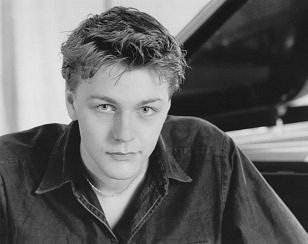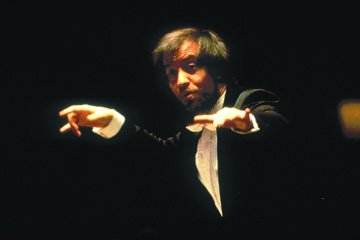S & H Concert Review
Gergiev conducts the Kirov: Balakirev, Rimsky-Korsakov, Borodin, Musorgsky (orch. Ravel), Rachmaninov, Alex Slobodyanik (pf), Kirov Orchestra, Valery Gergiev, Barbican Hall 8th – 9th November 2002 (MB)
8th November
Balakirev – Islamey
Rimsky-Korsakov – Sheherazade
Borodin – In the Steppes of Central Asia
Musorgsky (orch. Ravel) – Pictures at an Exhibition9th November
Rachmaninov – Isle of the Dead
Rachmaninov – Piano Concerto No.4
Rachmaninov – Symphony No. 2
For the past two evening’s packed houses at the Barbican have been treated to a feast of Russian music which, depending on your viewpoint, will either have left you reeling from a sense of disbelief or recoiling from the event entirely. There is little doubt, for example, that Valery Gergiev, despite his unquestionable talents as a conductor, is one of the most infuriating interpreters currently performing before the public (I have heard him conduct some of the most sublime Wagner imaginable and yet days later the worst Rite of Spring (with the Philharmonia) I have ever heard). These concerts provided the evidence, in spades, of a conductor with a uniquely self-deprecating style but one with an almost pathological desire to re-shape the music he performs, and not always to its advantage. There is never any black and white in a Gergiev interpretation, and his capacity to surprise is astonishing. He can border on the visceral or the anodyne, often within the same performance. It was simply inconceivable, for example, that after one of the slowest performances of Sheherazade I have ever heard we would the next evening get one of the fastest performances of Rachmaninov’s Second Symphony I can recall. Yet, that is exactly what we got.Such contradictions are part of the man. He stands not on a podium but with his orchestra directly on the stage. For entire performances he will use a baton, for others he simply won’t touch one. He either gyrates like a puppet or stands virtually motionless. Interestingly, and I think significantly, he sits his orchestra very tightly together – there was literally acres of spare stage space at the front of the platform throughout both concerts. The effect is to concentrate the orchestral sound in a special way – there is much greater density to the tonic and an almost stereophonic balance so the most subtle pianissimos carry across the hall with extraordinary clarity. The obverse is that the brass can sound brash – a single tuba resonating, for example, with quite thunderous effect. The sound will certainly not be to everyone’s liking but there is little doubt it is thrilling; moreover, he coaxes playing of extraordinary refinement from the Kirov players. Throughout both concerts the playing reached levels that were inspired, but what really made these special events was the sheer passion of the orchestra. In spite of the sometimes perverse deliberation of the interpretations the performances were never less than committed.
The performance of Sheherazade is a case in point. Most orchestras could simply never contemplate a performance of this work that lasted for almost an hour – yet the playing was simply stunning. The menacing opening of The Sea and Sinbad’s Ship had formidable tonal weight and when balanced with the beautifully shaped violin solos of Sergy Levitin, so sinuous in their orientalism, the effect was diaphanous. In terms of the imagery Gergiev conveyed this was a performance which splashed with the sound of the sea. Only in the second movement, The Kalendar Prince, did the sonority of the brass threaten to swamp the performance – yet, even when it threatened to Gergiev somehow maintained the element of fantasy so emblematic of a great performance of this work. Superb string tone made The Young Prince and The Young Princess a sumptuous experience with the interplay between the violin and clarinet as mellifluous as one could expect. If there was a problem with the first three movements of this work it was the idiosyncratic tempi – pulled to quite inordinate lengths at times – which sometimes hindered the melodic line. What cannot be questioned, however, is the sheer fire and velocity with which Gergiev permeated the final movement – Festival at Baghdad – The Sea. The brilliance of the orchestration glitteringly conveyed the festivities but nothing could have prepared us for the way that Gergiev handled the storm. It ripped through the orchestra with quite astonishing force. The crunching of percussion and the blistering, herald-like sonorities of the brass were not only brilliantly articulated they were played with almost Titanic strength. It was as ear shattering as it was earth shattering.
The performance of Musorgsky’s Pictures at an Exhibition was as driven as Sheherazade had been idiosyncratic. Generally, the sense of artistry was never in doubt, Gergiev’s view of each picture an individual tableau of fractal-like colouring. There were some disappointments – neither ‘Tuilleries’ nor the ‘Marketplace at Limoges’ bristled with sufficient bite. Woodwind were neither as witty in the former nor as chastening in the latter than they might have been. Other pictures were marked out by some extraordinary playing, however. ‘Bydlo’, for example, produced a ravishing tuba solo the brightness of which immersed the hall in a glowing halo of sound. ‘Catacombs’ was dark and intense, and ‘Baba-Yaga’ was entrenched in sinisterness. Gergiev launched ‘The Great Gate of Kiev’ with considerable flair giving the movement the architectural massiveness it required. If metre in Sheherazade has occasionally been compromised it was sustained perfectly in Pictures to give the performance an edginess and inevitability which proved completely compelling.
Gergiev’s second concert was all Rachmaninov, and if it didn’t quite match the incandescence of his first concert was still packed with moments of high drama and theatricality. None more so than a fabulous performance of The Isle of the Dead, one of the darkest and most brooding works Rachmaninov ever wrote. Similar to Musorgsky’s Pictures in that Rachmaninov takes as his inspiration a work of art – in this case Arnold Böcklin’s The Isle of the Dead – it is music of extraordinary power. It began evocatively – the opening five-note motif symbolically depicting the beating of oars as Charon rows across the Styx. Dark, sombre strings were counter-balanced against a throbbing drum beat, brass were curdling in their depiction of the ‘life’ theme. All extraordinarily evocative.

Programming The Isle of the Dead and the Second Symphony, both works from around 1907, one of the composer’s most intense periods of composition, was inspired; programming the Fourth Piano Concerto had implied dangers. It is a work which went through numerous revisions and by the early 1940s was no longer even a part of Rachmaninov’s own repertoire as pianist or conductor. It certainly requires a pianist of unusual skill to bring it off in concert and at first I thought the young Russian Alex Slobodyanik was rather beyond that. This concerto, more than any of the preceding three, needs scintillating technique beside an intuitive ability to make the music sound greater than it is. Slobodyanik began rather wistfully – the opening lacked a certain gravitas – and some of his phrasing during the opening allegro lacked the conviction required to make the movement sparkle; too often his pedalling was softer than it might have been, and too often his grasp of keyboard colour was too monochromatic. Gergiev’s accompaniment was certainly not to blame for this since he allowed his young soloist considerable latitude with pacing; indeed, it was not until the first movement’s cadenza that Slobodyanik finally grasped the keyboard by the throat and threw caution to the wind. From then on he projected colour quite magnificently distilling a sense of lyricism into the second movement which had been conspicuously lacking in the first; by the third movement he had settled sufficiently to bring genuine cataclysm to Rachmaninov’s perilous scoring: trills were paced with velocity and octaves sprung from his fingers with consummate ease.
Of all the works played in these concerts it was Rachmaninov’s Second Symphony which surprised me the most because Gergiev’s approach to it proved so unpredictable. Earlier in the year, André Previn had given an incandescent account of this symphony with the London Symphony Orchestra, a performance notable for the incredibly dark-hued playing of the LSO strings. That was almost taken for granted here – the Kirov strings being imbued with that uniquely Russian graininess no other non-Russian orchestra seems capable of reproducing in Russian symphonies.
Comparing the two performances it is apparent that Gergiev – like so many of his Russian predecessors, but notably Mrvainsky and Sanderling - views this symphony less from a lyrical perspective and more from an impassioned one firing the work with an almost anti-Romantic sweep. This was the one work which Gergiev conducted without a baton, and the way he used his hands to elicit the most intense dynamics proved astonishing. With none of the undisciplined rubato that has disfigured some of his symphonic work on record and in the concert hall this was as straight a performance of the symphony as I can recall. The astringency of the playing was remarkable – its passion, wildness, ferocity and toughness mesmerising. But what marked this out as a great performance was the inevitability of the symphony’s argument with the flow between the movements so utterly ‘right’. In a symphony notorious for its ability to drag this performance seemed not a note too long.
The adagio, for example, had an unrestrained lyricism. A magnificent solo clarinet, played by Ivan Tersky, was hypnotic (and what peerless breath control) but other solos during this movement were equally palpable for their sense of rubato-less simplicity – a flute, a bassoon, a horn. Driven by a lacerating tempo the finale produced playing that raged and raged. It was incandescent: blazing trumpets, horns and trombones and timpani (especially magnificent cymbals which had such clarity) were effortlessly projected. The string articulation in the closing pages was simply sublime.
This was by no means the most subtle performance of the symphony I have heard but its authentic Russian feel certainly made it one of the most exciting.
Encores on both evenings were thrown off with frightening speed. A hyperbolic ‘Dance of the Tumblers’ on the first night was driven to the edge of impossibility, at a daringly fast tempo, and, similarly, the Prelude to Lohengrin on the second night was blistering in its speed. Both were notable for summing up what all of these concerts had been about showcasing: a passion for music. Many will have been thrilled by the music-making, some enraged by it. Gergiev divides opinions as few conductors performing today tend to. I’ve experienced both sides to the man, but on this occasion am more than willing to admit he thrilled me more than he enraged me.
Marc Bridle

 Return to:
Return to: